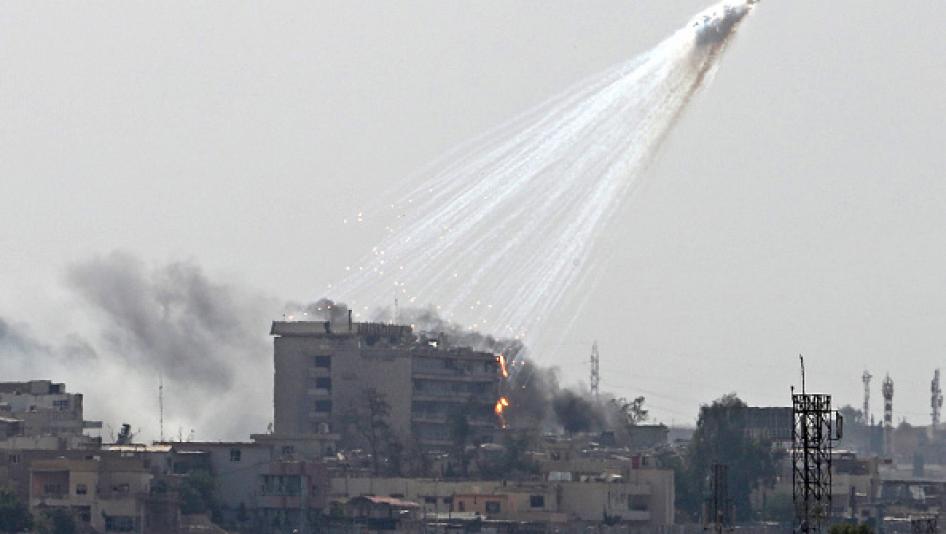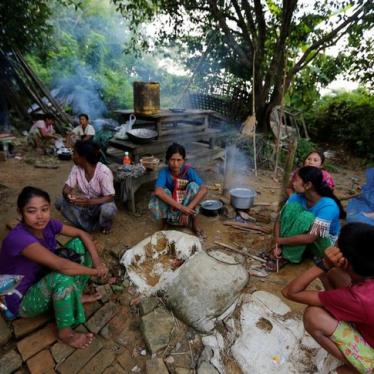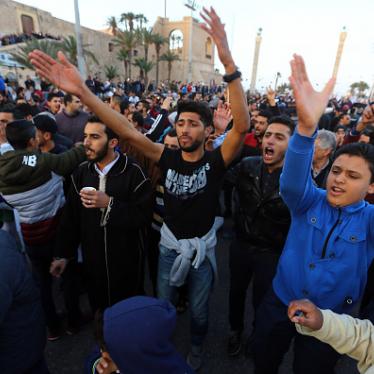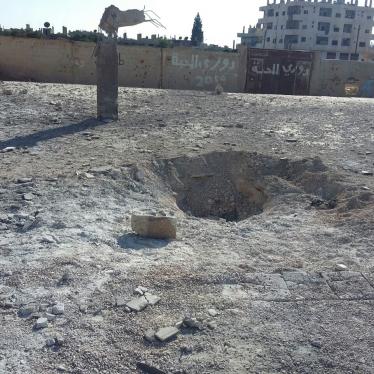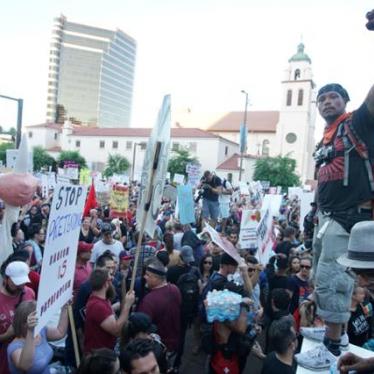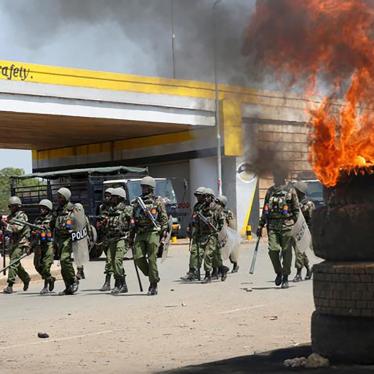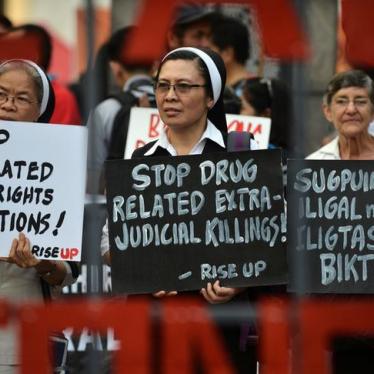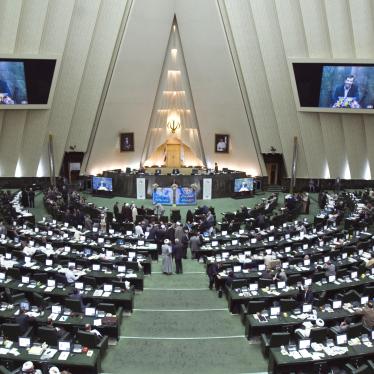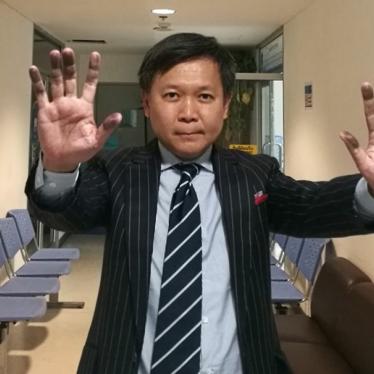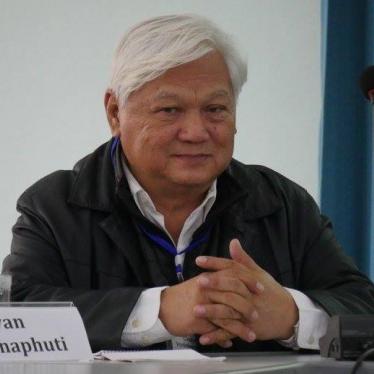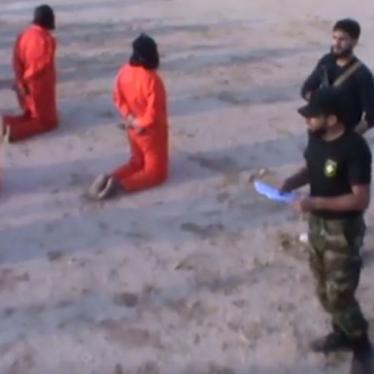Smoking and burning white phosphorus streaks to the ground in west Mosul on June 2, 2017.
“No matter how white phosphorus is used, it poses a high risk of horrific and long-lasting harm in crowded cities like Raqqa and Mosul and any other areas with concentrations of civilians,” said Steve Goose, arms director at Human Rights Watch. “US-led forces should take all feasible precautions to minimize civilian harm when using white phosphorus in Iraq and Syria.”
White phosphorus munitions can be used for several purposes on the battlefield: as an obscurant or smoke screen, for signaling and marking, and as an incendiary weapon. US forces are using white phosphorus in both Mosul, in Iraq, and in the ISIS stronghold of Raqqa, in Syria. But the rationale for its use by US-led coalition forces is unclear as the coalition does not comment on specific incidents.
Human Rights Watch was not able to independently verify whether the use of the munitions resulted in any civilian casualties. A Raqqa resident living in Beirut told the New York Times that an internet cafe in Raqqa was recently hit by white phosphorus, killing around 20 people.
In Syria, a video published on Facebook on June 8, 2017, and reported on Facebook as shot that day in Raqqa, shows the use of ground-fired artillery projectiles containing white phosphorus, which are distinctive when air-burst. Another video broadcast by Amaq News Agency, an ISIS-linked news outlet, purports to show the same incident with fires on the ground started by white phosphorus, but its veracity cannot be determined. A video published online on June 10 suggest further use of white phosphorus on June 9.
In early 2017, US Marine artillery deployed to Syria in support of the operation to retake Raqqa, an operation in which Syrian Democratic Forces (SDF) are also participating. The Washington Post published photographs of the deployed Marine unit equipped with white phosphorus projectiles, as well as similar pictures showing white phosphorus projectiles with US Army units outside Mosul. The SDF announced the offensive to take Raqqa from ISIS on June 6. The reason for this use of white phosphorus cannot be determined from the videos, which shows white phosphorus being used just after sunset.
Footage shot in Mosul, Iraq on June 3 also shows the use of ground-fired projectiles containing white phosphorous. Smoke from ground fires is also visible in the video, but it is unclear if these were ignited by white phosphorus or caused by something else. Since mid-February, Iraqi forces supported by the US-led coalition have been engaged in an offensive to retake densely populated west Mosul.
The purpose of this use of white phosphorus is unclear, but Iraqi Security Forces (ISF) stated on June 4 that it was used to create a smoke screen. According to a US-led coalition comment to media on the use that Human Rights Watch obtained: “While protecting civilians fleeing from the Jamouri Hospital the Coalition used smoke and precision munitions to suppress the enemy and provide cover for fleeing civilians. In conjunction with Iraqi Security Forces, the Coalition used appropriate munitions to suppress and obscure ISIS snipers so that the civilians could reach friendly forces.”
In both Mosul and Raqqa, the US-led forces are using US-made M825-series 155mm artillery projectiles containing 116 felt wedges impregnated with white phosphorus, which ignites and continues to burn when exposed to the air. This is the only type of 155mm white phosphorus projectile in US stocks that can be air-burst. Neither ISIS nor Syrian government forces are known to possess or have used these US-made munitions.
The US-led coalition states that as a matter of policy it cannot publicly discuss the use of specific munitions, but admits to using white phosphorus in its operation in Iraq and Syria. US Army Col. Ryan Dillon, a spokesperson for the US-led coalition in Iraq and Syria, told international media on June 9 that, “in accordance with the law of armed conflict, white phosphorus rounds are used for screening, obscuring and marking in a way that fully considers the possible incidental effects on civilians and civilian structures.”
In the Mosul incident, the projectiles burst very close to the ground in what seems to be an attempt to minimize the footprint of the effects. In Raqqa, videos appear to show the munitions bursting higher in the air, spreading the white phosphorus over a much wider area.
White phosphorus ignites when exposed to atmospheric oxygen and continues to burn until it is deprived of oxygen or exhausted. Its chemical reaction can create intense heat (about 815° C/1500° F), light, and smoke. White phosphorus can thus be used for marking, signaling, and obscuring, but it can also be used as a weapon to set fires that burn people and objects.
On contact, white phosphorus can also burn people, thermally and chemically, down to the bone as it is highly soluble in fat, and therefore in human flesh. White phosphorus fragments can exacerbate wounds even after treatment and can enter the bloodstream and cause multiple organ failure. Already dressed wounds can reignite when dressings are removed and they are re-exposed to oxygen. Even relatively minor burns are often fatal.
Attacks using air-delivered incendiary weapons in civilian areas are prohibited under Protocol III of the Convention on Conventional Weapons (CCW). While the protocol contains weaker restrictions for ground-launched incendiary weapons, all types of incendiary weapons produce horrific injuries. Protocol III applies only to weapons that are “primarily designed” to set fires or cause burns, and thus some countries believe it excludes certain multipurpose munitions with incendiary effects, notably those containing white phosphorus.
Lebanon became the 114th country to ratify CCW Protocol III on April 5, 2017. Iraq, Russia, and the US are parties to the protocol, while Syria has not ratified it.
From 2000 to 2016, white phosphorus munitions were reportedly used in at least seven conflicts – Afghanistan, Gaza, Iraq, Lebanon, Somalia, Ukraine, and Yemen. In 2016, the Saudi Arabia-led coalition in Yemen used artillery-delivered white phosphorus munitions.
Syrian government forces are not known to have used white phosphorus, but Human Rights Watch has documented the use of air dropped Soviet or Russian-made incendiary weapons in the country since 2012, and in their operations with Russian forces since late 2015. Human Rights Watch has repeatedly called on the Syrian-Russian coalition to cease their use of incendiary weapons in Syria.
“Horrific civilian harm from previous use of white phosphorus has generated public outrage and this latest use of white phosphorus underscores the urgent need for states to strengthen international law relating to incendiary weapons,” Goose said.

